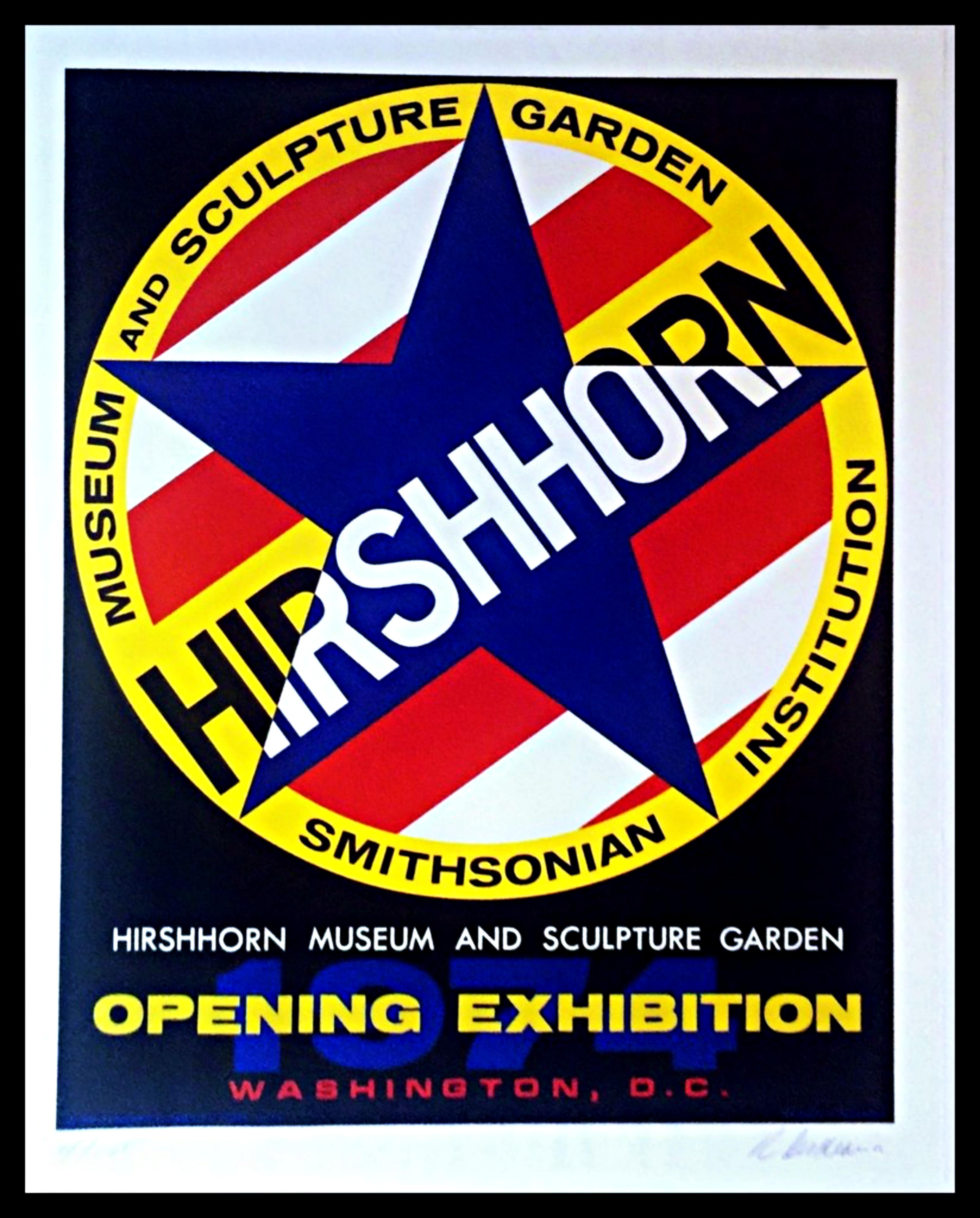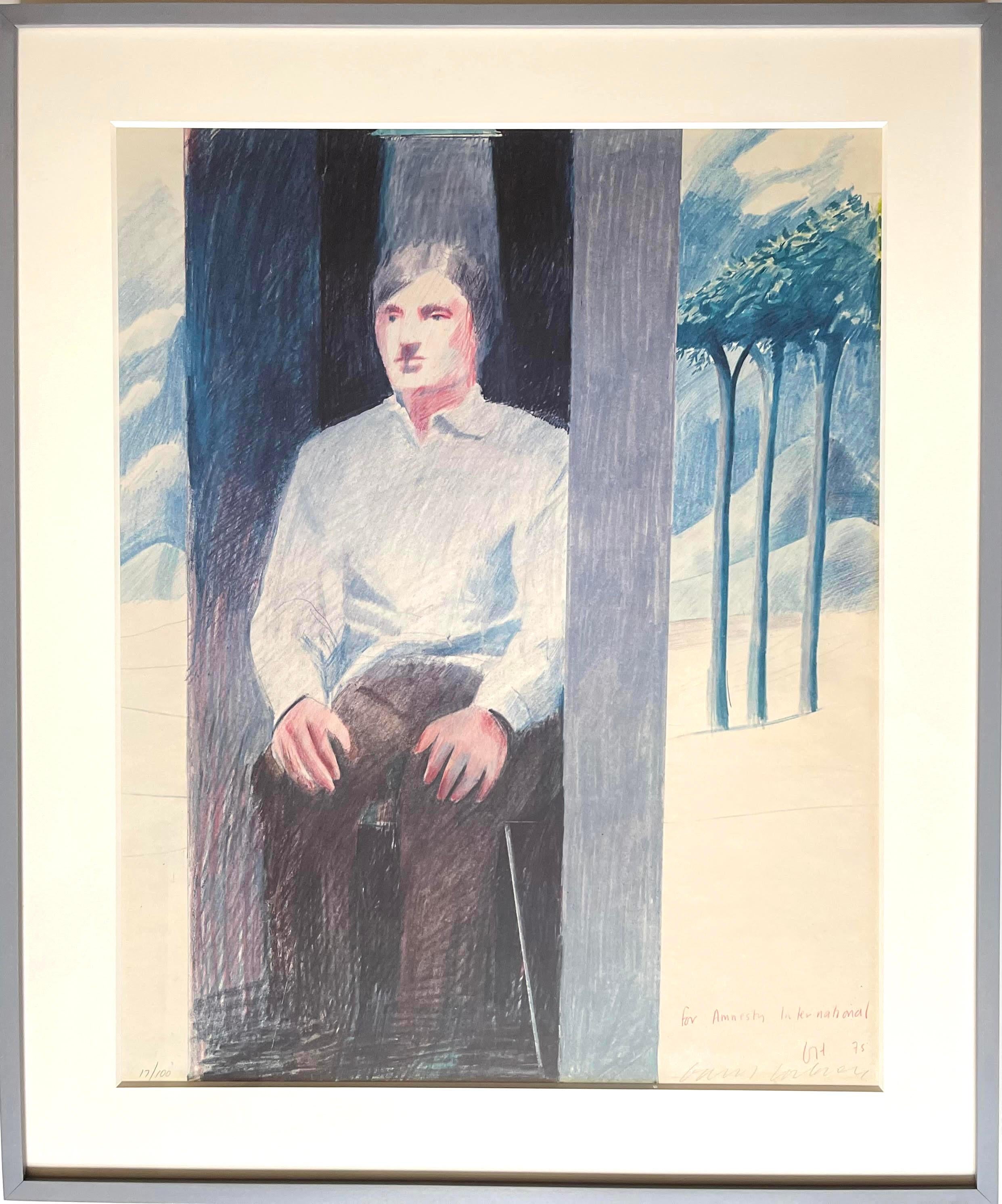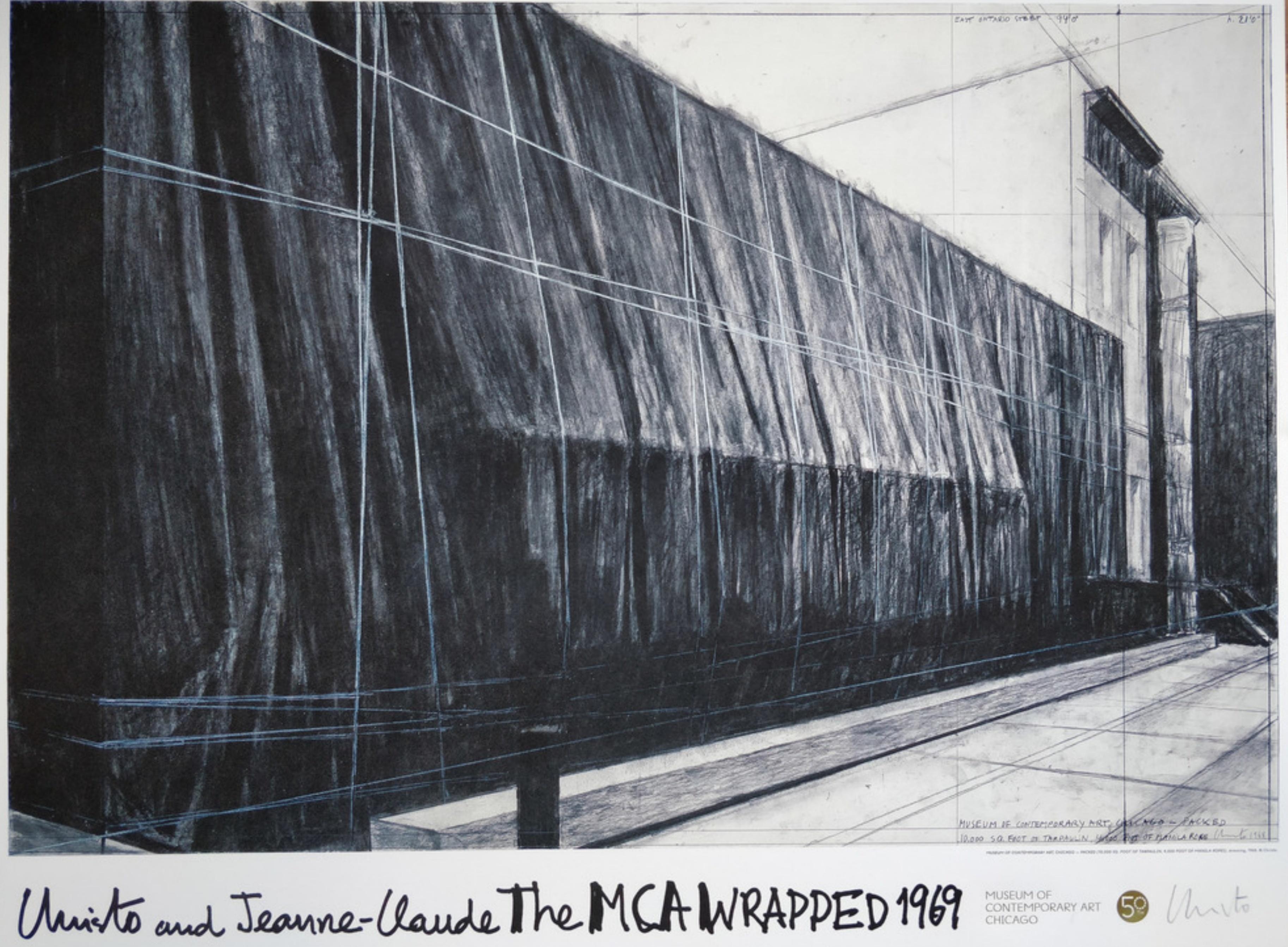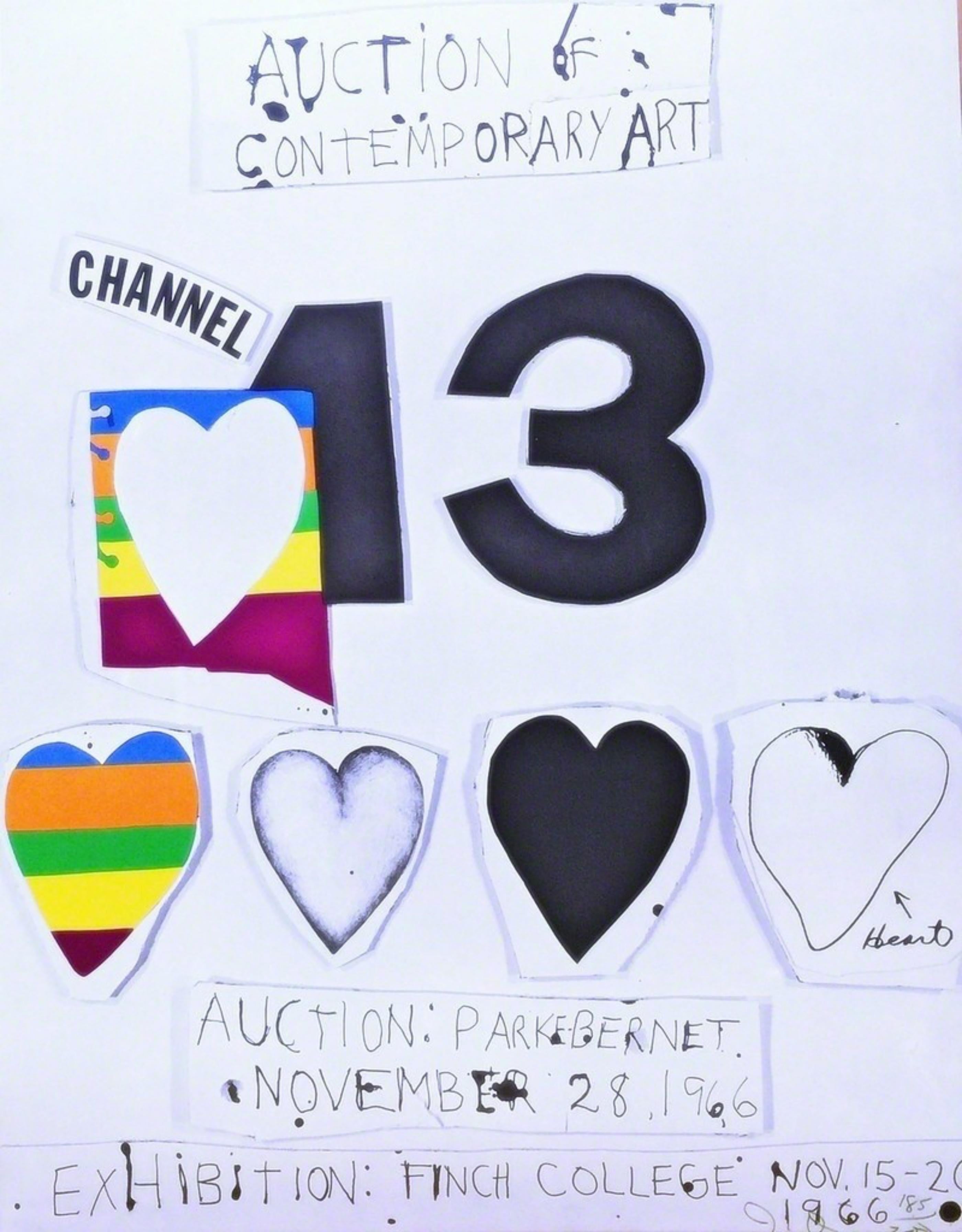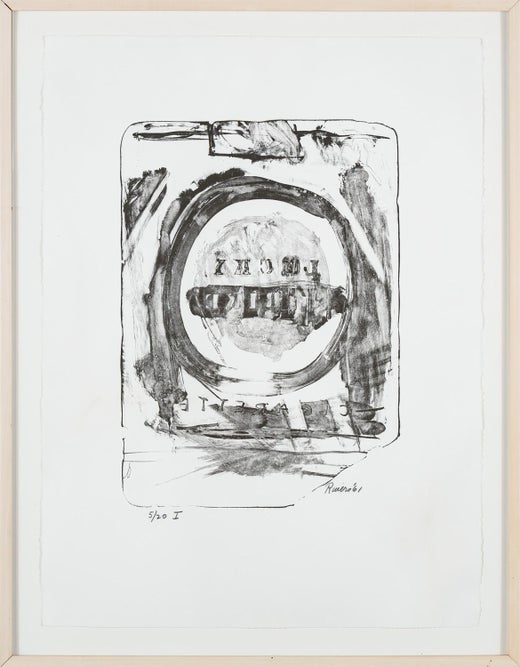Larry RiversVintage Pop Art 1997 Offset Lithograph Larry Rivers Music Poster Hamptons NY1997
1997
About the Item
- Creator:Larry Rivers (1923 - 2002, American)
- Creation Year:1997
- Dimensions:Height: 24 in (60.96 cm)Width: 18 in (45.72 cm)
- Medium:
- Movement & Style:
- Period:
- Condition:
- Gallery Location:Surfside, FL
- Reference Number:1stDibs: LU38211460672
Larry Rivers
Figurative artist Larry Rivers was born in the Bronx in 1923 to Ukrainian Jewish parents, and was named Yitzak Loiza Grossberg. Rivers belonged to the second generation of the New York School of painters, although unlike most of his contemporaries he stayed away from abstraction instead preferring narrative paintings. He began his artistic career playing the jazz saxophone, and when one night his group was introduced as "Larry Rivers and the Mudcats," he decided to keep the name.
After a brief period in the army during World War II, Rivers attended Juilliard School of Music for one year before returning to the jazz saxophone. After he met the painter Jane Freilicher, he decided to devote himself to painting. Rivers attended Hans Hofmann's school for nearly two years. In 1949, he had his first solo show at the Jane Street Gallery, an artist's co-op in the Village. Rivers received favorable reviews and was invited to join the Tibor de Nagy Gallery uptown.
Rivers continued to show annually at the Tibor de Nagy Gallery from 1952 to 1962. In 1963, he joined the Marlborough Gallery, where he stayed until his death. In 1955, The New York Museum of Modern Art acquired his painting Washington Crossing the Delaware, and in 1956 the Whitney Museum purchased Double Portrait of Berdie, two of his more famous paintings. He had periodic museum shows in Europe and the United States throughout his career.
Rivers had two sons, Joseph and Steven, by his first wife, Augusta. In 1961 he married Clarice Price and had two more children, Gwynne and Emma. In the 1970s he had another son with the painter Daria Deshuk.
The subjects of River's figurative paintings were family, history, politics, religion and sex. His work done in oils often included the use of stencils, cutouts, blank canvas and image reversals. He often painted family members including his mother in law, his sons and his ex-wife. Rivers favored historical subjects such as History of Matzah: The Story of the Jews (1984-85), History of the Russian Revolution (1965) and often painted parodies including his Washington Crossing the Delaware. He enjoyed controversial subjects and shocking the public. Lapman Loves It (1966) is a nine-foot electrified assemblage complete with strategically located light bulbs. French Vocabulary Lesson (1961-62) is a nude with body parts labeled in French.
Rivers was also a writer. In 1979 he published Drawings and Digressions with Carol Brightman. In 1992 he published What Did I Do? The Unauthorized Autobiography with Arnold Weinstein.
Find original Larry Rivers prints and paintings on 1stDibs.
(Biography provided by Lincoln Glenn)
- ShippingRetrieving quote...Ships From: Surfside, FL
- Return PolicyA return for this item may be initiated within 3 days of delivery.
- Joe Tilson British Pop Art Screenprint, Color Lithograph 4 Seasons 4 ElementsBy Joe TilsonLocated in Surfside, FLSilkscreen screenprint or Lithograph Hand signed and numbered. An esoteric, mystical, Kabbala inspired print with Hebrew as well as other languages. Joseph Charles Tilson RA (born 2...Category
1970s Pop Art Abstract Prints
MaterialsLithograph, Screen
- Vintage Modern Lithograph Poster 1960s Pop Art Mod FigureBy Richard LindnerLocated in Surfside, FLVintage 1960's Lithograph poster for Vancouver Canada art show. Richard Lindner was born in Hamburg, Germany. In 1905 the family moved to Nuremberg, where Lindners mother was owner o...Category
1960s Pop Art Abstract Prints
MaterialsLithograph
- 1971 Modernist Lithograph Redhead Pop Art Mod Fashionable Woman Richard LindnerBy Richard LindnerLocated in Surfside, FLRICHARD LINDNER (American. 1901-1978) Hand Signed limited edition lithograph with blindstamp Publisher: Shorewood-Bank Street Atelier for the Skowhegan School of Painting and Sculpture 29.25 X 22 inches Richard Lindner was born in Hamburg, Germany. In 1905 the family moved to Nuremberg, where Lindner's mother was owner of a custom-fitting corset business and Richard Lindner grew up and studied at the Kunstgewerbeschule (Arts and Crafts School since 1940 Academy of Fine Arts). From 1924 to 1927 he lived in Munich and studied there from 1925 at the Kunstakademie. In 1927 he moved to Berlin and stayed there until 1928, when he returned to Munich to become art director of a publishing firm. He remained there until 1933, when he was forced to flee to Paris, where he became politically engaged, sought contact with French artists and earned his living as a commercial artist. He was interned when the war broke out in 1939 and later served in the French Army. In 1941 he went to the United States and worked in New York City as an illustrator of books and magazines (Vogue, Fortune and Harper's Bazaar). He began painting seriously in 1952, holding his first one-man exhibit in 1954. His style blends a mechanistic cubism with personal images and haunting symbolism. LIndner maintained contact with the emigre community including New York artists and German emigrants (Albert Einstein, Marlene Dietrich, Saul Steinberg). Though he became a United States citizen in 1948, Lindner considered himself a New Yorker, but not a true American. However, over the course of time, his continental circus women became New York City streetwalkers. New York police uniforms replaced European military uniforms as symbols of authority.At a time when Abstract Expressionism was all the rage, Lindner’s painting went against the current and always kept its distance. His pictorial language of vibrant colours and broad planes of colour and his urban themes make him a forerunner of American Pop Art. At the same time, he owes the critical tone of his paintings to the influence of European art movements such as Neue Sachlichkeit and Dada. His first exhibition did not take place until 1954, by which time he was over fifty, and, interestingly, it was held at the Betty Parsons Gallery in New York, a venue associated with the American Expressionists. From 1952 he taught at the Pratt Institute, Brooklyn, from 1967 at Yale University School of Art and Architecture, New Haven. In 1957 Lindner got the William and Norma Copley Foundation-Award. In 1965 he became Guest Professor at the Akademie für Bildende Künste, Hamburg. His Ice (1966, Whitney Museum of American Art) established a connection between the metaphysical tradition and pop art. He did work on Rowlux which was used by a number of pop artists (most notably Roy Lichtenstein)The painting shows harsh, flat geometric shapes framing an erotic but mechanical robot-woman. His paintings used the sexual symbolism of advertising and investigated definitions of gender roles in the media. While influencing Pop Art (Andy Warhol, Tom Wesselmann and Claes Oldenburg amongst others) his highly colourful, hard-edge style seems to have brought him close to Pop Art, which he rejected. Nevertheless, he is immortalised on the cover of the Beatles record "Sgt. Pepper’s Lonely Hearts Club Band" (1967) as a patron of the pop culture. He also did a tapestry banner with the Betsy Ross Flag...Category
1970s Pop Art Abstract Prints
MaterialsLithograph
- Large American Pop Art Color Abstract Lithograph James Rosenquist Glass WishesBy James RosenquistLocated in Surfside, FLJames Rosenquist (1933-2017) THE GLASS WISHES (Glenn 161) Color lithograph, 1978-1986, on wove paper, hand signed, dated, titled, dedicated for Jack Martin...Category
1980s Pop Art Abstract Prints
MaterialsColor, Lithograph
- Judy Rifka Abstract Expressionist Contemporary Lithograph Hebrew 10 CommandmentBy Judy RifkaLocated in Surfside, FLJudy Rifka (American, b. 1945) 44/84 Lithograph on paper titled "Thou Shalt Not Bear False Witness against Thy Neighbor"; Depicting an abstract composition in blue, green, red and black tones with Hebrew script. Judaica interest. (I have seen this print described as a screenprint and as a lithograph) Hand signed in pencil and dated alongside an embossed pictorial blindstamp of a closed hand with one raised index finger. Solo Press. From The Ten Commandments Kenny Scharf; Joseph Nechvatal; Gretchen Bender; April Gornik; Robert Kushner; Nancy Spero; Vito Acconci; Jane Dickson; Judy Rifka; Richard Bosman and Lisa Liebmann. Judy Rifka (born 1945) is an American woman artist active since the 1970s as a painter and video artist. She works heavily in New York City's Tribeca and Lower East Side and has associated with movements coming out of the area in the 1970s and 1980s such as Colab and the East Village, Manhattan art scene. A video artist, book artist and abstract painter, Rifka is a multi-faceted artist who has worked in a variety of media in addition to her painting and printmaking. She was born in 1945 in New York City and studied art at Hunter College, the New York Studio School and the Skowhegan School of Painting and Sculpture in Maine. Rifka took part in the 1980 Times Square Show, (Organized by Collaborative Projects, Inc. in 1980 at what was once a massage parlor, with now-famous participants such as Jenny Holzer, Nan Goldin, Keith Haring, Kenny Scharf, Jean-Michel Basquiat, and Kiki Smith, the roster of the exhibition reads like a who’s who of the art world), two Whitney Museum Biennials (1975, 1983), Documenta 7, Just Another Asshole (1981), curated by Carlo McCormick and received the cover of Art in America in 1984 for her series, "Architecture," which employed the three-dimensional stretchers that she adopted in exhibitions dating to 1982; in a 1985 review in the New York Times, Vivien Raynor noted Rifka's shift to large paintings of the female nude, which also employed the three-dimensional stretchers. In a 1985 episode of Miami Vice, Bianca Jagger played a character attacked in front of Rifka's three-dimensional nude still-life, "Bacchanaal", which was on display at the Museum of Art Fort Lauderdale. Rene Ricard wrote about Rifka in his influential December 1987 Art Forum article about the iconic identity of artists from Van Gogh to Jean-Michel Basquiat and Keith Haring, The Radiant Child.The untitled acrylic painting on plywood, in the collection of the Honolulu Museum of Art, demonstrates the artist's use of plywood as a substrate for painting. Artist and writer Mark Bloch called her work "imaginative surfaces that support experimental laboratories for interferences in sensuous pigment." According to artist and curator Greg de la Haba, Judy Rifka's irregular polygons on plywood "are among the most important paintings of the decade". In 2013, Rifka's daily posts on Facebook garnered a large social media audience for her imaginative "selfies," erudite friendly comments, and widely attended solo and group exhibitions, Judy Rifka's pop art figuration is noted for its nervous line and frenetic pace. In the January 1998 issue of Art in America, Vincent Carducci echoed Masheck, “Rifka reworks the neo-classical and the pop, setting all sources in quotation for today’s art-world cognoscenti.” Rifka, along with artists like David Wojnarowicz, helped to take Pop sensibility into a milieu that incorporated politics and high art into Postmodernism; Robert Pincus-Witten stated in his 1988 essay, Corinthian Crackerjacks & Passing Go that "Rifka’s commitment to process and discovery, doctrine with Abstract Expressionist practice, is of paramount concern though there is nothing dogmatic or pious about Rifka’s use of method. Playful rapidity and delight in discovery is everywhere evident in her painting." In 2016, a large retrospective of Rifka's art was shown at the Jean-Paul Najar Foundation in Dubai. In 2017, Gregory de la Haba presented a Rifka retrospective at the Amstel Gallery in The Yard, a section of Manhattan described as "a labyrinth of small cubicles, conference rooms and small office spaces that are rented out to young entrepreneurs, professionals and hipsters". In 2019 her video Bubble Dancers New Space Ritual was selected for the International Istanbul Bienali. Alexandra Goldman Talks To Judy Rifka About Ionic Ironic: Mythos from the '80s at CORE:Club and the Inexistence of "Feminist Art" Whitehot Magazine of Contemporary Art. She was included in "50 Contemporary Women Artists", a book comprising a refined selection of current and impactful artists. The foreword is by Elizabeth Sackler of the Brooklyn Museum’s Sackler Center for Feminist Art. Additional names in the book include sculptor and carver Barbara Segal...Category
1980s Pop Art Abstract Prints
MaterialsLithograph, Screen
- Large American Pop Art Color Abstract Lithograph "Black Tie" James RosenquistBy James RosenquistLocated in Surfside, FLBlack Tie, 1977 James Rosenquist, American, 1933–2017. Printed by Maurice Sanchez at Derrière L'Étoile Studios, Inc. Published by Sidney Singer Color lithograph on rolled white Arches Cover paper Blindstamp of a man in a hat, bottom right Hand signed in pencil. Dated 1977 lower right. Titled and numbered 76/100 lower left. Measures 73 1/2" x 37 James Rosenquist (November 29, 1933 – March 31, 2017) was an American artist and one of the proponents of the pop art movement. Drawing from his background working in sign painting, Rosenquist's pieces often explored the role of advertising and consumer culture in art and society, utilizing techniques he learned making commercial art to depict popular cultural icons and mundane everyday objects. While his works have often been compared to those from other key figures of the pop art movement, such as Andy Warhol, JIm Dine and Roy Lichtenstein, Rosenquist's pieces were unique in the way that they often employed elements of surrealism using fragments of advertisements and cultural imagery to emphasize the overwhelming nature of ads. He was a 2001 inductee into the Florida Artists Hall of Fame. Rosenquist was born on November 29, 1933, in Grand Forks, North Dakota, the only child of Louis and Ruth Rosenquist. His parents were amateur pilots of Swedish descent who moved from town to town to look for work, finally settling in Minneapolis, Minnesota. His mother, who was also a painter, encouraged her son to have an artistic interest. In junior high school, Rosenquist won a short-term scholarship to study at the Minneapolis School of Art and subsequently studied painting at the University of Minnesota from 1952 to 1954. In 1955, at the age of 21, he moved to New York City on scholarship to study at the Art Students League, studying under painters such as Edwin Dickinson and George Grosz. Talking about his experience at the Art Students League, Rosenquist said "I studied only with the abstract artists. They had commercial artists there teaching commercial work, I didn't bother with that. I was only interested in -- see, here's how it started. I was interested in learning how to paint the Sistine Chapel. It sounds ambitious, but I wanted to go to mural school". While studying in New York, Rosenquist took up a job as a chauffeur, before deciding to join the International...Category
1970s Pop Art Abstract Prints
MaterialsLithograph, Color
- Early 1970s poster from Annely Juda Gallery, London (hand signed by Christo)By Christo and Jeanne-ClaudeLocated in New York, NYChristo and Jeanne-Claude Christo (Hand Signed by Christo), 1971 Offset lithograph Hand signed in pencil by the artist on the lower right front Published by Annely Juda Gallery, Lond...Category
1970s Pop Art Figurative Prints
MaterialsOffset, Lithograph
- Deluxe signed & numbered lithograph for the Hirshhorn Museum & Sculpture GardenBy Robert IndianaLocated in New York, NYROBERT INDIANA Hirshhorn Museum & Sculpture Garden Opening Exhibition (Signed & Numbered Edition), 1974 Lithograph on wove paper 32 × 26 inches Signed and numbered 4/100 in pencil on...Category
1970s Pop Art Abstract Prints
MaterialsLithograph, Offset
- The Prisoner, for Amnesty InternationalBy David HockneyLocated in New York, NYDavid Hockney The Prisoner, for Amnesty International, 1977 Color Offset Lithograph Hand signed, numbered 17/100 and inscribed by the artist on the lower right front Elegant hand mad...Category
1970s Pop Art Figurative Prints
MaterialsLithograph, Offset
- RAUSCHENBERG (Scarce and collectible early invitation)By Robert RauschenbergLocated in New York, NYRobert Rauschenberg and Cris Gianakos RAUSCHENBERG (Scarce and collectible early invitation), 1970 Offset Lithograph Invitation 8 7/10 × 11 9/10 inches Unframed Offset lithograph invitation created on the occasion of Robert Rauschenberg's exhibition at SVA's Visual Arts Gallery in 1970. The poster was designed by Cristos Gianakos, who was also a professor at SVA, and the show was curated by Felice Wender, the director of Dayon's Gallery 12 in Minneapolis. The invitation states that "after completing its New York debut, the show will open at the School of the Art Institute of Chicago in January 4, 1971 and continue through January 29, 1971. In May, 1971, Dayton's Gallery 12, Minneapolis, Minnesota will exhibit the new Rauschenberg works..." The text on this invitation additionally states that Rauschenberg said in a written statement about these works: "The image and the words cooperate to construct a flat re-reading of the facts plus familiar passing insignificancies that control our day. Information, originally engaged in a daily rhetorical screen to eliminate as much direct feeling and response as possible, re-exposed to encourage consideration..." In nearly a decade and a half of buying and selling art...Category
1970s Pop Art Abstract Prints
MaterialsLithograph, Offset
- The Wrapped (MCA), Chicago 1969 (Limited Edition of 200, Hand Signed by Christo)By Christo and Jeanne-ClaudeLocated in New York, NYChristo and Jeanne-Claude The Wrapped (MCA), 1969 (Hand Signed), 2019 Four-color offset lithograph on 110 lb. Crane Lettra Cover stock, with an elegant gold foil stamp. Hand Signed by Christo 22 3/5 × 30 inches Edition of 200 Hand-signed by artist, Signed in graphite pencil by Christo on the front. Also elegant gold foil stamp. Unnumbered from the documented limited edition of only 200 Published by Museum of Contemporary Art, (MCA) Chicago Unframed A great gift for anyone with ties to Chicago! This limited-edition, hand signed offset lithograph on 110 lb. Crane Lettra Cover stock commemorates Christo's exhibition "Wrap In Wrap Out", which took place at the MCA’s original location on 237 East Ontario Street, Chicago. The project became the first public building Christo and his wife, Jeanne-Claude, wrapped in the United States. In an illuminating 2010 article entitled, "A daring plan to wrap a Chicago museum raises city ire – and makes art history," author Robin Amer recounts how Christo came to choose Chicago -- or rather how Chicago chose New York based artist Christo: "During a recent conversation he [Christo] ticked off the list of buildings he approached in downtown Manhattan starting in 1961. “Number 2 Broadway, number 20 Exchange Place,” he recalled. “We tried to wrap a building at Times Square. They all said no. Christo said he quickly realized that his best hope to wrap a building – his first in North America – would be to wrap a museum, which might be more amenable to his strange proposition.Christo and Jeanne-Claude approached New York’s Museum of Modern Art in 1967. The museum was interested, but Christo said they failed to secure permission for the show from the New York Fire...Category
1960s Pop Art Abstract Prints
MaterialsFoil
- Five Hearts for Channel 13 (Public Television), deluxe hand signed limited ed.By Jim DineLocated in New York, NYJim Dine Love for Channel 13 Lithograph. Hand signed and numbered recto 27 × 21 1/2 inches Edition 185/200 Signed and numbered 185/200 in graphite pencil on the recto Unframed Rarel...Category
1960s Pop Art Figurative Prints
MaterialsLithograph, Offset, Pencil

